As noted in the Khadas VIM1S announcement, the company is also preparing to launch the Khadas Edge2 single board computer with a Rockchip RK3588S octa-core Cortex-A76/A55 processor and a thickness of just 5.7mm (before a low-profile heatsink is installed).
The new board follows a similar form factor as the original Khadas Edge board powered by a Rockchip RK3399 processor, except the edge connector is gone, so it can’t be used as a system-on-module anymore, but remains the thinnest and one of the most powerful Arm SBCs so far.
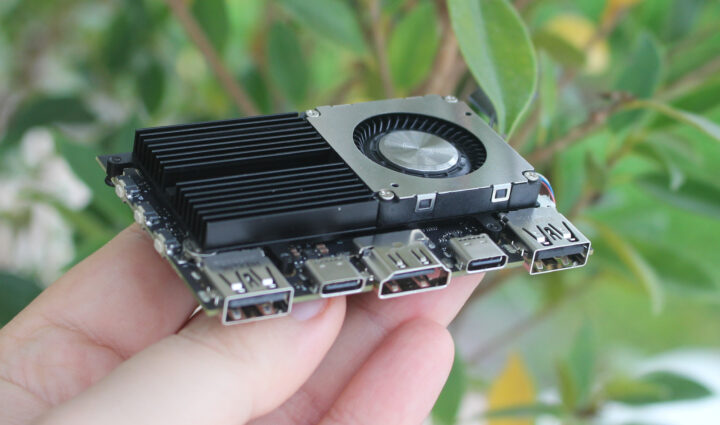
Khadas Edge2 Basic/Pro specifications:
- SoC – Rockchip RK3588S
- CPU – Octa-core processor with four Cortex-A76 cores @ 2.25 GHz, four Cortex-A55 cores @ 1.8 GHz
- GPU – Arm Mali G610MC4 GPU
- AI accelerator – 6TOPS NPU
- VPU
- 8Kp60 10-bit H.265 decoder, 4Kp60 AV1 video decoder
- 8Kp30 H.264/H.265 video encoder
- MCU – STMicro STM32G031K6 Arm Cortex-M0+ microcontroller @ 64 Mhz for power management and boot selection (eMMC or SPI flash)
- System Memory and Storage
- Khadas Edge2 Basic – 8GB LPDDR4x @ 2112 MHz and 32GB eMMC 5.1 flash
- Khadas Edge2 Pro – 16GB LPDDR4x @ 2112 MHz and 64GB eMMC 5.1 flash
- 32SPI flash for OOWOW system
- Video Output
- HDMI 2.1 up to 8Kp60 with HDR, CEC, DSC 1.2a, and HDCP 2.3
- USB-C DisplayPort 1.4 up to 4Kp60
- 30-pin 4-lane MIPI DSI connector up to 4Kp60
- 40-pin 4-lane MIPI DSI connector up to 4Kp60 adding I2C and GPIO signals required for touch panel support
- Four independent displays supported (TBC)
- Audio – Stereo digital microphones, digital audio output via HDMI and USB-C
- Camera I/F – 3x 4-lane MIPI CSI connectors
- Connectivity – Dual-band 802.11 ax/ac/a/b/g/n WiFi 6 2T2R and Bluetooth 5.0 via Ampak AP6275P module, two antennas
- USB
- 1x USB 3.1 Type-A port, 1x USB 2.0 Type-A port
- 1x USB 3.1 Type-C port for data, DisplayPort Alt mode, and USB PD support
- 1x USB Type-C port for power only (USB PD)
- Expansion
- 2x 30-pin IO connectors
- CPU signals: I2C, UART, SPI, SDMMC, I2S, ADC, PWM, USB
- MCU signals: SWDIO, SWCLK, UART
- 7x pogo pads with USB, UART, 5V, GND
- 2x 30-pin IO connectors
- Misc
- 4-pin PWM fan header
- KXTJ3-1057 3-axis accelerometer
- 3V RTC battery
- 2x RGB LEDs
- 3x buttons (Reset, Func, and Power)
- Power Supply
- USB Type-C ports with USB PD support
- XPWR pads for an external power button
- Dimensions – 82 x 57.5 x 5.7 mm (without heatsink), about 11mm thick with heatsink and fan.
- Weight – 25 grams
- Certifications – RoHS, CE, FCC, TELEC, KC
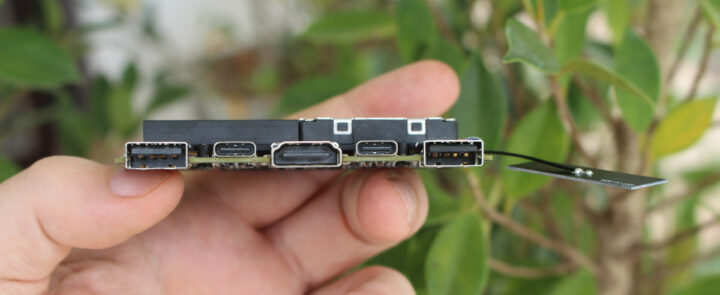
Making a 5.7mm ultra thin SBC means you have to do without perks such as Ethernet or a typical female GPIO header, although those can be added through a USB dock or the Edge2 IO extension board. There’s no microSD card socket either. That’s probably why Khadas has the VIM family with all of those features such as the recently launched Khadas VIM4.
The company provides Ubuntu 22.04 and Android 11/12 images with Linux 5.10 that can be installed through the OOWOW system that provides a menu to download and install the images from Khadas server. Khadas also highlights the Fenix one-click script for building Linux distributions.
I’ve reviewed the Khadas Edge2 Pro SBC with Ubuntu 22.04, and as expected, performance is similar to the Rockchip RK3588-powered ROCK5 Model B board, but Linux support has already improved since my ROCK 5B preview in July. You can also check out the Android 12 review, especially if you are interested in an OS that supports hardware video decoding and 3D graphics acceleration.
Update: September 20, 2020. Khadas Edge2 has launched for $229.90 and up.
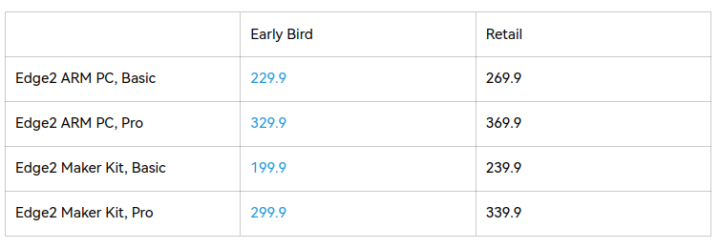
Khadas promises to ship the Edge2 Maker Kits ship within 2 days once the order is confirmed, and Edge2 ARM PCs will ship on or before mid-December 2022.

Jean-Luc started CNX Software in 2010 as a part-time endeavor, before quitting his job as a software engineering manager, and starting to write daily news, and reviews full time later in 2011.
Support CNX Software! Donate via cryptocurrencies, become a Patron on Patreon, or purchase goods on Amazon or Aliexpress


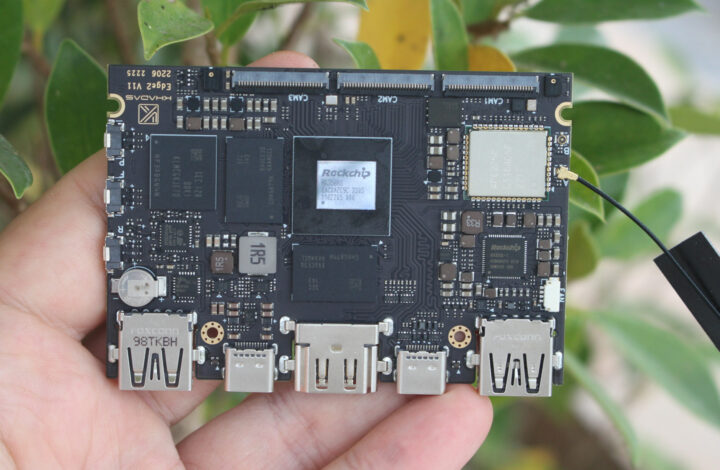
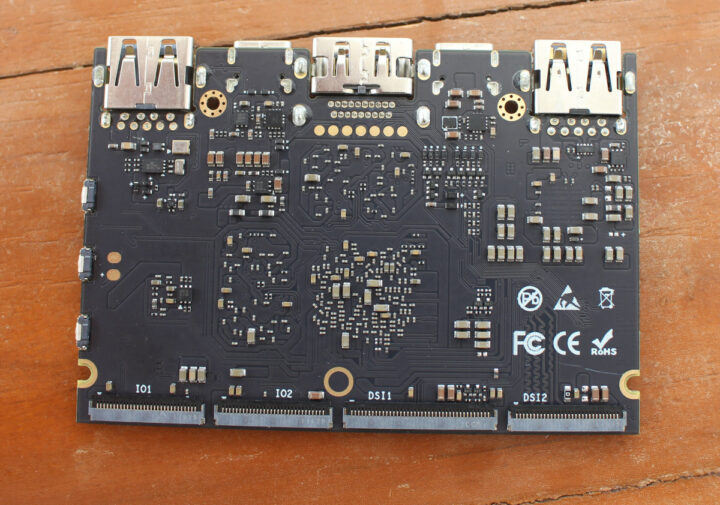


Looks excellent, I have thought for some time the density offered by standard GPIO is starting to be legacy.
You have 2x 30-pin IO connectors in a fraction of the space and likely you should be able to get a daughter board that will have a Pi compatible layout and not the usual almost Pi like musical chairs pin mux revision that some SBC go through.
The RK358x SBC’s even though a price hike on what Raspberry offer the performance gains easily match and make some very interesting alternatives.
My only gripe is why when you have all IO on one plane and connectors that can use riser cables, why have hardware switches on the side of the board whilst just plain old jumpers like normal Mobo’s are far more flexible with the choice of wired switches?
Thank you for your compliments, yes we’re committed to producing SBCs with superior performance characteristics as compared with raspberry Pis. We maintain the existing 40-pin GPIO layout as it is familiar to many Makers and increases the likelihood of cross compatibility with existing hardware and peripherals. That being said, we understand where you are coming from, and your suggestions regarding the density of GPIO pins and the fact that jumpers will provide more control options, are also being considered. We will adjust the layout of our SBCs as we observe the evolution of the general market. But first and foremost we must always consider the needs of the majority of users.
> four Cortex-A76 cores @ 2.25 GHz
I don’t think this applies to RK3588S or Edge2 in general. More likely your review board is just equipped with a ‘weaker’ RK3588S. According to sbc-bench results collection we’ve seen with RK3588S a variation of maximum clockspeeds between 2.25 GHz and 2.33 GHz so far: http://ix.io/4alD
The highest we’ve measured with any RK3588 is 2.35 GHz as such I think PVTM works the same on both SoCs and we’re just seeing silicon variation.
That number does not come from my testing, but from the specifications provided by Khadas.
OPP is 2304 MHz, but the measured frequency (in sbc-bench) is about 2250 MHz on that board in Ubuntu 22.04.
So they play safe (since ~2250 MHz is actually the lowest we’ve measured so far with RK3588 too). And if their customers are lucky they get a RK3588S on their Edge2 that clocks up to 100 MHz higher (doesn’t matter much anyway, the performance impact is negligible).
Yep, you are correct that not all the RK3588/S chips able to run the frequency to 2.4GHz as the statement in the datasheet: some does able to hit 2.4GHz but still quite many not while shipped out from the wafer factory.
So we just label the Edge2 specs with the real number of 2.25GHz.
> So we just label the Edge2 specs with the real number of 2.25GHz.
That’s a really great and honest practice and you guys should be applauded for this brave move!
You see, the “mhz” and “sbc-bench” tools were designed at the era vendors were lying like crazy to the point that HK who made their sales speech on the claimed 2 GHz frequency of their Odroid-C2 suddenly experienced a cold shower when discovering it was false advertising with them being among the victims of the silicon vendor lies (and probably the largest victim in the end). This marked a turn, with board vendors being more careful about what they were selling, not believing anymore the lies from amlogic nor rockchip. And now we’ve finally reached the point where the *tested* frequency, not the *claimed* one, is the one advertised on the board. That’s really awesome, it will very likely set a precedent and could show a new trend. Many many thanks guys!
While it’s nice that Edge2 is marketed with measured clockspeeds Khadas still uses fake clockspeeds for VIM1 and VIM2 even just recently here – both boards are locked at 1.4GHz while Khadas’ specs claim 1.5GHz.
With the other Amlogic Khadas boards it’s more complicated since they spec for example VIM3 as 2.2/1.8 GHz but discovered recently that there are Amlogic boot BLOBs floating around that allow A311D/S922X to be clocked with 2.4/2.2 GHz.
TBH, I don’t know the history behind this, I’m just observing a positive move and a honest intent. Maybe the rest will follow. It can sometimes take time. Maybe the 1.4 vs 1.5 results from a technical problem and they don’t want to update the spec because they’re stlil testing and keeping hopes to solve it. Remember the espressobin disaster ? 1.2 GHz then finally 1.0 then 800M, then 1.0 sometimes… I don’t know if anyone ever decided on a final frequency, but for sure I know some users who gave up trying anything above 800M.
Regarding VIM3, I’m not surprised. My Odroid-N2+ (S922X) runs stable at 2.4/2.0, but I suspect that nobody including amlogic themselves has ever known what frequency their chips should be clocked at. And since they continue to lock them down using their blobs, that doesn’t leave much room for end users nor board vendors to experiment and report success :-/
> My Odroid-N2+ (S922X) runs stable at 2.4/2.0
All do since Hardkernel did their homework early on and got the right BLOBs. VIM3/VIM3L OTOH: https://pastebin.com/raw/2bsCwjSa
AFAIK (not interested in anything Amlogic anyway) LibreELEC guys collect those BLOBs in their amlogic-boot-fip repo where 3rd parties like Armbian pull those from. As such the discrepancies in clockspeeds between ‘vendor OS image’ and LibreELEC/Armbian.
Initial excitement was followed by meh.
I believe that pricing will likely have to be below $100 to gain any real attention, which I am not optimistic about.
The Rock5B seems to offer the best overall value of those that are generally/imminently available.
Khadas adds a few features here and there like the STM32 microcontroller and accelerometer, and they don’t usually try to compete on price alone, so I’d expect it to be quite over $100.
> pricing will likely have to be below $100
Khadas is not known to address the ‘as cheap as possible crowd’ and just look at the components: eMMC (hopefully one with a high TBW rating since only storage option for an OS drive asides USB), RAM and PCIe attached 2×2 MIMO Wi-Fi 6.
As for the Rock 5B comparison: asides targeting some different use cases I’m still baffled that people let fool themselves by irrelevant ‘list prices’ w/o taking into account all the additional costs until they have the thing in their hands and working.
Agreed, and actually I find it quite nice that we’re seeing different products address different use cases. Vendors dropping the RPi form factor give them a lot more freedom in terms of I/O and use cases, and they’re probably listening much more to their regular customers. It’s great if they can all try to refine their product without having to copy the neighbor nor step on each others’ feet.
When I saw the pictures (missing Ethernet) my first thought was you would complain 😉
Seriously, use cases like robotics, drones, digital signage or smashing this thing into a DIY laptop or tablet came immediately to my mind. The latter a bit bulky compared to today’s standards but slim and elegant compared to those ugly bricks marketed as RPi 4 laptop or tablets. Pogo pads with USB and 5V on them also open certain neat opportunities.
> When I saw the pictures (missing Ethernet) my first thought was you would complain 😉
That was my surprise offered to cnxsoft not to complain for once 🙂
> Seriously, use cases like robotics, drones (…)
Agreed. For workstations/servers etc Ithink the segment is very well addressed by Rock 5B. That doesn’t mean one cannot do better, but the board is designed based on exchanges with potential customers and it should work very well there. It’s clear there will be other segments (small laptops are indeed a good example) which need power and small size. This one makes sense there. Maybe at some point we’ll see an R6S with multiple ethernet ports focusing on yet another segment and that will be fine. The end of the race to the absolute lowest price can be good for quality and innovation. No more need to sacrifice a NOR here or a console port there to save 30 cents total and ruin a product on poor user experience.
> The end of the race to the absolute lowest price
Don’t forget that an RK3588S equipped Orange Pi 5 is on its way 😉
Also basing on RK’s reference design (32GB eMMC, same PCIe attached AP6275P Wi-Fi/BT module as on Edge2, power via USB-C but most probably skipping USB PD / FUSB302) it will be less expensive but not exactly cheap.
Nobody outside of a select few in the dev community can obtain a Rock5B. Ship dates have been missed again (was August 2022) and I’ve seen no news of when they plan to ship.
Radxa never made the mistake to announce a real shipping date. They always ‘expected’ something happening sometimes. So here we go again: https://forum.radxa.com/t/where-can-i-buy-a-rock-pi-5/11517/3?u=tkaiser 😉
Thanks. I’ve been watching the “debug party” thread and didn’t see this announcement.
They’ve significantly improved the board’s layout to address the problems with cooling difficulties and misplaced screws. Just for this I think one prefers to wait a few more weeks rather than have to deal with the first version during all the product’s life.
I’m not going to get excited about a new Khadas board until they get the old board working first. The VIM4 is a near perfect platform for my purposes, but video acceleration under Linux is non-existent, killing the deal.
No point in having amazing specs if the OS/Software is unable to take advantage.
Khadas as almost every other board maker provides Linux support in the sense of using the SoC vendor’s BSP kernel for the specific SoC. Read the thread ‘Demystifying Odroid N2 hardware acceleration’ over at ODROID forum to get an idea what you would’ve to do to get HW accelerated vp9 and H264 decoding.
As for Edge2 you might want to monitor closely what happens with Rock5B since same SoC –> same software support situation.
CoreELEC is using video acceleration under Linux so it’s far from non-existent.
The question which Linux you want 🙂
It is the fault of Linux wanting everything for free.
You either monetize the OS, put a percentage on hardware for software development.
Highly unlikely to happen, the users donate dollars to fund development of wanted software features. Universal drivers for RISC V or Arm Linux drivers.
It is software that drives AMD, Intel, Nvidia sales.
Go crazy have a Linux , with Android frontend and drivers ( no Google lock in )
Linux could start to say, want to use or brand, community software. Then hardware must provide drivers.
Don’t see it happening myself.
Thanks for the posting!
Actually, the Edge2 Pro is equipped with 16GB RAM 🙂
I was wondering why the Pro added +32 GB of eMMC and nothing else.
Did you get to test it with the casing in the link below?
https://www.khadas.com/events
I don’t have the enclosure.
Looks like an enclosure with passive cooling.
Looks like indeed, and I’m pretty sure that the chip is prefectly capable of running fanless, based on the tests I’ve run on the (expectedly more power-hungry) rock5b. I predict that these both powerful and power-efficient chips will start to appear everywhere in the upcoming year.
It’s active actually, with a cooling fan 🙂
You are absolutely right. Saw it after the launching date. Thanks for the heads-up.
Does anyone reading here with industry experience know how the Rockchip 8 Llp nm and Amlogic 12nm nodes compare, advantages, disadvantages ?
I like this layout ! all the SBCs should have a “flat” version.
What is the required power ? 5v and A ?
Count USB3 ports (each has to provide 5V @ 900mA) and you know it. Asides that the use case determines ‘power requirements’ since with CPU loads alone you’ll have a hard time exceeding 10W.
A question not directly related to this board: we would like to have access to ARM Trusted Firmware for RK3588. Unfortunately, it seems that Rockchip does not work on upstream ATF for RK35XX products, only RK33XX are supported currently. RK35XX BL31 firmware are only available as binary through rkbin repo.
Does anybody have any information on the Rockchip policy about this topic. Any chance that RK35XX will be supported by upstream ATF in the (near) future ?
Regards,
Romain
I was hoping for an updated Edge (or Edge-V, although I prefer the Edge format for my purposes) for some time now. Great to see this upgrade, as the Edge2 could be a great DIY smartglass “dongle” (think Rokid, Viture, Nreal, not the shitty Bose/Xiaomi “smart” glasses that only have a BT speaker in them).
The only thing I’m missing is the Juice board connector. It’s a sad omission, as such a tiny board, combined with a nice big battery pack, would be an ideal portable mini PC for all sorts of purposes. I wonder why the port was removed – it did not seem to take much place on the original Edge/Edge-V, as most of the PM components were on the Juice board itself, and the SBC only provided an (I presume I2C) communication port for the PMIC, and two (or three?) power rails.
Hi, fonix and Edge1 user(I guess),
Actually, to support Juice board for battery pack, quite many MOFET compoments and circuit logistic are required to built into the Edge board. You can check the Edge/-V schematic for the further details.
To be honest, the Juice board does sell good so we thought this feature might not needed for most users.
But, anyway, thanks for the kind feedback and I will farward the point to our product manager.
Have fun!